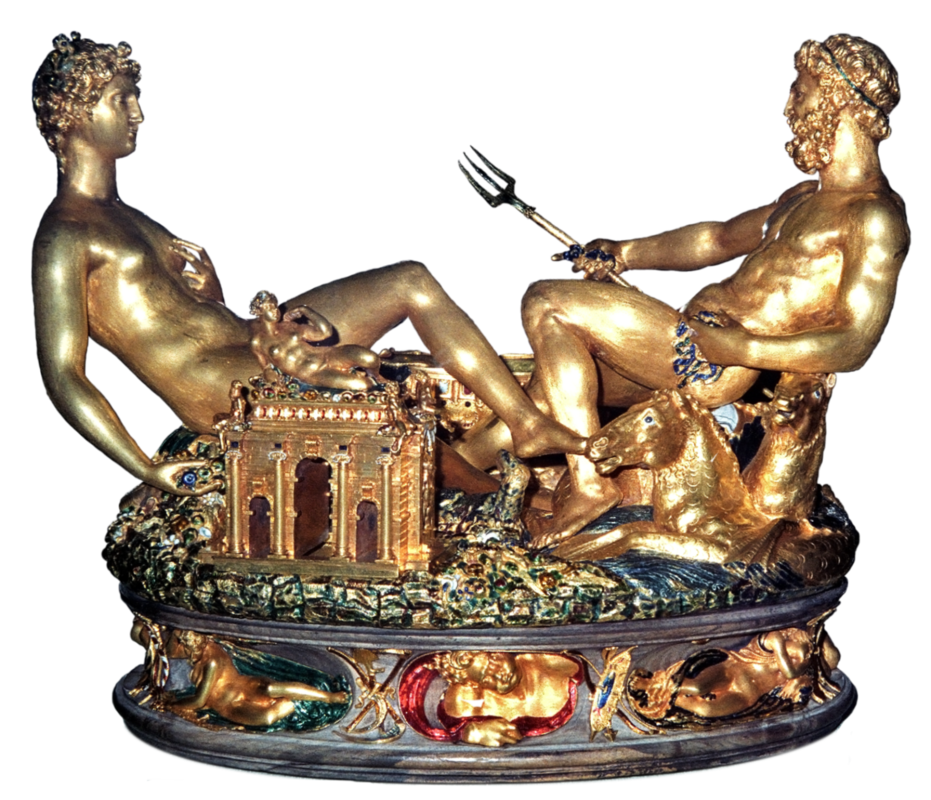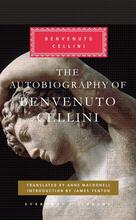More about Saliera
- All
- Info
- Shop

Contributor
This tiny salt cellar is a story of twisted romance, stolen art, and buried treasure.
As the only solid gold sculpture that Cellini ever made, the nude lady enjoying some self-exploration represents Ceres, the goddess of agriculture, and she’s lounging next to her very own temple that stores peppercorns. The hunky gent sitting across from her represents Neptune, the god of the ocean, and he’s chilling with a boat that holds salt. Cellini made this salt cellar for King Francis I of France between 1540 and 1543 while he was living in Paris.
The cellar was a gift to Francis from King Charles IX of Sweden. Charles needed to make an apology present because couldn’t be bothered to show up to his own wedding to Elisabeth of France and Francis stood in for him as one does. Apparently in the 1500s showing up to your own wedding was more of a suggestion than an obligation.
Somehow this little sculpture found its way to the Kunsthistorisches Museum in Vienna, which was ironically the most dangerous place for it to wind up. In May 2003, a 50 year old security alarm specialist named Robert Mang climbed up a scaffolding on the outside of the building, broke a second floor window, and stole the 60 million dollar salt cellar. While Mang waited for the 12 million dollar ransom that he politely requested from the Kunsthistorisches insurance company, the salt cellar stayed safely stashed underneath Mang’s bed… for two years. It seems like that didn’t work out so well so Mang moved the cellar into a lead box and buried it in the forest.
Come January 2006 and Mang’s plan fell apart. He’d used several cell phones to send ransom texts to the police, but one day Mang decided to treat himself to a new cell phone. Police were able to trace the text to the cell phone, trace the cell phone to the store it was purchased from, and then get a picture of Mr. Mang from the store’s security cameras. When the police made the picture public, Robert Mang did the honorable thing and turned himself in. Huzzah for the happy ending!
The salt cellar was a little worse for wear after its adventure under the bed and in the box, but the Kunsthistorisches Museum decided not to have the sculpture restored, saying that all the scratches were now just part of the piece’s story.
Sources
- Bernstein, Richard. "For Stolen Saltcellar, A Cellphone Is Golden." The New York Times, January 26, 2006. Accessed December 1, 2017. http://www.nytimes.com/2006/01/26/arts/design/for-stolen-saltcellar-a-c….
- "Salt Cellar by Benvenuto Cellini." Web Gallery of Art. Accessed December 01, 2017. https://www.wga.hu/html_m/c/cellini/1/index.html.
- "Sogenannte Saliera." Kunsthistorisches Museum. Accessed December 01, 2017. http://www.khm.at/objektdb/detail/87080/.
Featured Content
Here is what Wikipedia says about Cellini Salt Cellar

The Cellini Salt Cellar (in Vienna called the Saliera, Italian for salt cellar) is a part-enamelled gold table sculpture by Benvenuto Cellini (c.1500-1571). It was completed in 1543 for Francis I of France (r.1515-1547), from silver plate models that had been prepared many years earlier for Cardinal Ippolito d'Este (c.1479-1520).
Functioning as more than just an expensive condiment holder, the cellar aimed to catapult conversation among intellectuals on the underlying meanings of the work. During the Renaissance, the Saliera was notable for its Mannerism. The main draw is the work's style and form, which Cellini discusses in his treatise, I trattati dell'oreficieria e della Scultura (Treatises on Goldsmithing and Sculpture) and in his autobiography. The work is the only extant gold sculpture by Benvenuto Cellini and is most famous of extant gold sculpture work to survive from the Renaissance. Ultimately, acting as a paradigm for 'renaissance gold smithery,' the sculptor showcased the multifaceted meanings of small objects of the era.
Famously stolen in 2003, the salt cellar was recovered in 2006 and the thief was imprisoned.
Check out the full Wikipedia article about Cellini Salt Cellar













